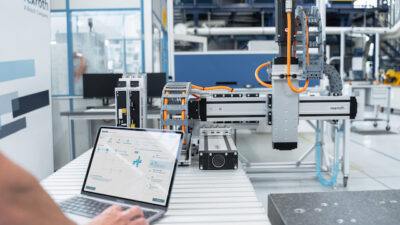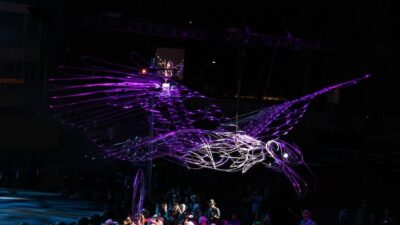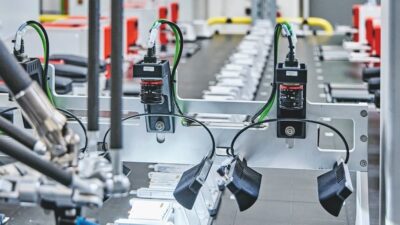Any vendors can take a voltage or current signal from sensors, capture a waveform, and perform some analysis. Two can take waveform analysis to another level. Sciemetric (Nepean, Ontario, Canada) and Rockwell Automation (Milwaukee, Wis.) have applied additional mathematics to waveform signals, offering tools to improve manufacturing quality and productivity.
|
Any vendors can take a voltage or current signal from sensors, capture a waveform, and perform some analysis. Two can take waveform analysis to another level. Sciemetric (Nepean, Ontario, Canada) and Rockwell Automation (Milwaukee, Wis.) have applied additional mathematics to waveform signals, offering tools to improve manufacturing quality and productivity.
These processes perform tool monitoring in machining applications; replace most, if not all, automobile engine hot test during assembly; improve pressing operations; monitor tooling; and serve many other manufacturing applications.
‘A lot of people are just template matching,’ says Nathan Sheaff, Sciemetric’s ceo. ‘We do a lot of math on the data because matching may not catch many problems that appear only when various attributes are also analyzed. While other tools may look at peaks, we look at the entire wave. Often we can reliably find the ‘needle in the haystack’ while avoiding nuisance hair-trigger faults.’
Steve McMahon, Sciemetric’s vp, explains that computer-based data acquisition and control technology have widespread abilities to monitor and control manufacturing processes. Major advancements in electronic measurement technology have resulted in a wide range of standard instruments with high precision and high reliability at reasonable cost. Systems are available that measure and record data; analyze the results in real time; present reports and graphics on video monitors; continuously check that all monitored parameters are within acceptable limits; and interact with the process by issuing shut-down or failure signals as necessary.
Signature analysis system from Sciemetric includes capturing a waveform from processes, processing the information, and making a decision, then archiving for future analysis.
Signature analysis explained
Signature analysis, in its simplest form, compares a specific process response, or waveform, to an acceptable pre-determined response.
By ‘instrumenting’ a manufacturing process with appropriate sensors, such as load-cells, pressure sensors, or displacement gauges, consistent and repeatable signals can be obtained that directly indicate the consistency and quality of the process or product. The signals could be physical measurements or computed values, such as horsepower or efficiency, based on specific measurements and mathematical formulas. Assuming measured variables and sensors are chosen with care, the characteristic waveform should be consistent if the manufacturing operation is under control, and if product quality levels are maintained.
One example application is wire crimp monitoring. The operation involves mechanically crimping a copper terminal onto a stranded or solid copper wire. Total crimp duration is usually in the millisecond range (i.e., 20-30 msec). The force-distance response curve is the primary indicator of the process (although force vs. time is adequate in most cases). A consistent and repeatable curve will result for ‘normal’ crimp operations, assuming materials remain the same. The shape and characteristics of the force-distance curve will exhibit distinct changes if, for example, plastic insulation is caught under the terminal, if several strands of wire are missing from the wire itself, or if the terminal is misformed and becomes caught under the crimp head.
In a press-fit operation, the interference fit between parts dictates the operation’s tolerance and rate of change of force with respect to insertion distance (i.e., the slope of certain segments of the force-distance curve, the width of the curve, and the maximum force). Acceptable or ‘good’ press operations will result in a characteristic and repeatable force vs. distance signature. If the tolerance fit changes with insertion distance, this curve may have notable hills or valleys, even though the ‘peak’ force and press duration may be within acceptable limits.
A typical signature analysis system includes sensors or transducers, signal conditioning and amplification circuitry, an analog to digital converter, input trigger channels, relay output channels, a processor or microcomputer, and software to analyze the data. Systems are available with multiple channels and with different types of signal conditioning to handle different sensors. Software acquires data and performs a comparative analysis on measured or computed waveforms. Depending on outcome, the system can take appropriate action, such as displaying data on a video screen, activating a control output, sending signals to a PLC, or saving data to a disk file.
Sensors or transducers are commercially available for almost any physical quantity. Which to use for a given signature application depends on the manufacturing process.
Empirical signature systems memorize the response of the process as it runs for a number of ‘good’ parts or operations. More advanced signature systems contain software, which can systematically decompose a characteristic curve into identifiable segments for further analysis. Although most systems can also learn nominal curves empirically, more advanced analysis tools can considerably improve reliable fault detection.
Mathematical analysis
The degree of analysis that can be performed on a curve or multiple curves is almost unlimited when using a computer. It can include simple X-Y curve analysis, and more advanced algorithms of multi-dimensional variables, time-periodic waveforms, or frequency-domain response curves (FFT).
The most appropriate analysis depends on physical behavior of the process being measured. Where possible, signature analysis should compute and compare those parameters of the curve that have the most engineering or physical significance. A designer or process engineer involved with the product or process being measured will be in a position to specify what response characteristics should be examined, and what limits should be placed on these parameters. With this integration of design engineering and testing, product quality can be dramatically improved.
If a signature analysis system cannot be programmed to automatically adapt to changing signature conditions, the system could fail good parts. Equally important, if the signature system incorporates automatic learning capability or adaptive learning, if the algorithms are not selected correctly, or if they are too aggressive, the system could pass bad parts. Since the range of manufacturing processes to which signature analysis can be applied is tremendous, flexibility in learn and auto-learn capabilities is paramount to realizing a reliable testing system.
More sophisticated signature analysis systems will include a range of learning options.
Today, signature analysis systems are used by the automotive, electrical, electronic, mechanical, and aerospace industries. Whether the system is empirical or performs more advanced analysis, application of the technology is growing rapidly.
Automated tool monitoring
Rockwell Automation’s Automated Tool Monitor uses waveform signature analysis in machining applications to determine tool breakage and predict when tool wear will cause bad parts. Dave Mays, program manager, Smart Sensors Group, Rockwell Automation Global Technical Services, says achieving continuous production uptime is a never-ending challenge facing production engineers, tooling and project managers across all industries. The challenge is even greater in higher rate machining environments, where worn or broken tools will not only shut down a line, but can have a major impact on product quality.
Tool Monitor is designed as an integral part of the central machine control system to provide convenient access to machining and tooling information. Unlike ‘probe’ machines, which require the addition of separate workstations to confirm part production, this product eliminates separate add-ons, conserving space, time, and money.
This technology provides a base of predictive information about tool conditions and central-control integration that enables immediate machine shut down upon an unexpected tool break. Further, it provides video output to show specific power conditions, per spindle, while capturing and recording historical tool status information under powerload.
Rockwell Automation’s Automated Tool Monitoring System detects tool wear and tool breaks on an electrically powered tool performing a repetitive, high rate machining operation. It accomplishes this by measuring the power usage of a spindle drive motor.
First, normal power level is established, using known good tools. Upper and lower power limits or ‘bands’ are established, and actual power use during subsequent machining operations is evaluated relative to these limits. In addition, both the spindle motor power use curve and the upper and lower control limits can be displayed on a video monitor following the completion of each machining cycle.
During a cycle, the system reports tool condition, allowing the machine control system to shut down a spindle motor when conditions exceed acceptable limits. The complete Tool Monitor System comprises an Allen-Bradley Open Controller, Tool Monitor System software, a set of standard analog and digital I/O cards, a signal conditioning module, a power transducer for measuring spindle motor power, and an optional video display monitor.
The power graphs provide a look at the range of power being consumed under typical manufacturing conditions. The first graphic shows normal power use for a spindle motor performing a single cycle machining operation with good tools. The centerline represents output from the power transducer. It shows a low level of motor power prior to engaging the part, higher power use during machining, and a lower level after the tool exits the work piece. This verifies a normal machining cycle. As a tool begins to wear, the motor uses more power during the machining cycle, as indicated in the second figure, where power use during machining is stable and flat, but rises to a higher level during the machining process, indicating normal tool wear. These bands are updated regularly so that they will increase with normal tool wear, thus avoiding nuisance stops.
As tools become dull, they require more power for machining. As a result, power use during the machining operation will rise as shown in the last figure. When a tool breaks, power use makes an abrupt change-moving outside acceptable limits. Under these conditions, Tool Monitor recognizes that a tool has broken and issues an immediate stop signal to the machine control system.
Automatic limit adjustments
Limits are adjusted for normal tool wear automatically. This automatic learning process is performed periodically, using data from a predetermined number of good machining cycles. A cycle is determined to be good when the pattern of motor power use is within acceptable limits. In this way, the system automatically adjusts, without operator intervention, for normal tool wear, minimizing nuisance stops.
These exciting new tools can help controls engineers improve product quality and machine uptime simultaneously. The technology will certainly be added to control engineers’ tool bag in the future.
Tooling Problems Revealed
This waveform represents a capture of good parts and tooling for subsequent comparisons.
As a tool begins to wear, the motor will reflect more power used during the machining cycle, as indicated in this waveform.
As tools become dull, power use during the machining operation will rise as shown, but when a tool breaks, the Tool Monitor tracks the abrupt change.



